Impact of Water Level Variation on Mechanical Properties of Porous Concrete
Abstract
:1. Introduction
2. Experimental Programs
2.1. Materials
2.2. Preparation of Specimens
2.3. Testing Programs
2.3.1. Compressive Strength
2.3.2. Determination of Physical and Hydraulic Properties
3. Results
3.1. Influence of Water Table on Compressive Strength of Porous Concrete
3.2. Influence of Porosity on the Physical and Hydraulic Properties of the Porous Concrete
3.2.1. Density
3.2.2. Permeability
3.2.3. Observed Porosity
4. Conclusions
- The oven-dried condition resulted in the highest compressive strength for both cubical and cylindrical specimens. Compressive strength peaked at 40% water level and decreased at 60% due to cementitious particle separation by the pore water. A slight increase was observed at the 100% water level, possibly due to pore closure and free water flow.
- Increasing porosity led to a decrease in both density and compressive strength. This may be attributed to the presence of a larger number of voids, reducing the effective load-carrying area. The observed porosity values were consistently higher than the target porosities, due to compaction limitations.
- Porosity directly impacts the permeability of porous concrete, showing a linear correlation. Higher porosity leads to increased permeability due to the presence of more open voids, offering a larger surface area for water to infiltrate.
Author Contributions
Funding
Institutional Review Board Statement
Informed Consent Statement
Data Availability Statement
Acknowledgments
Conflicts of Interest
Abbreviations
| ACI | American Concrete Institute |
| ACV | Aggregate Crushing Strength |
| AIV | Aggregate Impact Value |
| ASTM | American Society for Testing and Materials |
| IS | Indian Standard |
| PC | Porous Concrete |
| SSD | Saturated Surface Dry |
| UTM | Universal Testing Machine |
| w/c | water to cement ratio |
References
- Yang, J.; Jiang, G. Experimental study on properties of pervious concrete pavement materials. Cem. Concr. Res. 2003, 33, 381–386. [Google Scholar] [CrossRef]
- Volder, A.; Watson, T.; Viswanathan, B. Potential use of pervious concrete for maintaining existing mature trees during and after urban development. Urban For. Urban Green. 2009, 8, 249–256. [Google Scholar] [CrossRef]
- Feng, B.; Zhang, Y.; Bourke, R. Urbanization impacts on flood risks based on urban growth data and coupled flood models. Nat. Hazards 2021, 106, 613–627. [Google Scholar] [CrossRef]
- Zhang, K.; Bach, P.M.; Mathios, J.; Dotto, C.B.S.; Deletic, A. Quantifying the benefits of stormwater harvesting for pollution mitigation. Water Res. 2020, 171, 115395. [Google Scholar] [CrossRef] [PubMed]
- Moretti, L.; Di Mascio, P.; Fusco, C. Porous Concrete for Pedestrian Pavements. Water 2019, 11, 2105. [Google Scholar] [CrossRef]
- Muda, M.M.; Legese, A.M.; Urgessa, G.; Boja, T. Strength, Porosity and Permeability Properties of Porous Concrete Made from Recycled Concrete Aggregates. Constr. Mater. 2023, 3, 81–92. [Google Scholar] [CrossRef]
- Singh, A.; Sampath, P.V.; Biligiri, K.P. A review of sustainable pervious concrete systems: Emphasis on clogging, material characterization, and environmental aspects. Constr. Build. Mater. 2020, 261, 120491. [Google Scholar] [CrossRef]
- Trojan, M.D.; Gulliver, J.S.; Fairbairn, D.J. Groundwater Impacts from Stormwater Infiltration Practices. In Encyclopedia of Water; Wiley: Hoboken, NJ, USA, 2020; pp. 1–17. [Google Scholar]
- Zhang, K.; Yong, F.; McCarthy, D.T.; Deletic, A. Predicting long term removal of heavy metals from porous pavements for stormwater treatment. Water Res. 2018, 142, 236–245. [Google Scholar] [CrossRef] [PubMed]
- Alimohammadi, V.; Maghfouri, M.; Nourmohammadi, D.; Azarsa, P.; Gupta, R.; Saberian, M. Stormwater Runoff Treatment Using Pervious Concrete Modified with Various Nanomaterials: A Comprehensive Review. Sustainability 2021, 13, 8552. [Google Scholar] [CrossRef]
- Xie, N.; Akin, M.; Shi, X. Permeable concrete pavements: A review of environmental benefits and durability. J. Clean. Prod. 2019, 210, 1605–1621. [Google Scholar] [CrossRef]
- Rodak, C.M.; Jayakaran, A.D.; Moore, T.L.; David, R.; Rhodes, E.R.; Vogel, J.R. Urban stormwater characterization, control, and treatment. Water Environ. Res. 2020, 92, 1552–1586. [Google Scholar] [CrossRef] [PubMed]
- Tirpak, R.A.; Winston, R.J.; Feliciano, M.; Dorsey, J.D.; Epps, T.H. Impacts of permeable interlocking concrete pavement on the runoff hydrograph: Volume reduction, peak flow mitigation, and extension of lag times. Hydrol. Process. 2021, 35, e14167. [Google Scholar] [CrossRef]
- ACI Committee 522. Report on Pervious Concrete 522R-10; American Concrete Institute: Farmington Hills, MI, USA, 2010. [Google Scholar]
- Ibrahim, H.A.; Razak, H.A.; Abutaha, F. Strength and abrasion resistance of palm oil clinker pervious concrete under different curing method. Constr. Build. Mater. 2017, 147, 576–587. [Google Scholar] [CrossRef]
- Latif, A.A.; Putrajaya, R.; Ing, D.S. A Review of Porous Concrete Pavement: Compressive Strength and Clogging Investigation. J. Adv. Res. Appl. Sci. Eng. Technol. 2023, 29, 128–138. [Google Scholar]
- Chen, Y.; Wang, K.; Wang, X.; Zhou, W. Strength, fracture and fatigue of pervious concrete. Constr. Build. Mater. 2013, 42, 97–104. [Google Scholar] [CrossRef]
- Chindaprasirt, P.; Hatanaka, S.; Chareerat, T.; Mishima, N.; Yuasa, Y. Cement paste characteristics and porous concrete properties. Constr. Build. Mater. 2008, 22, 894–901. [Google Scholar] [CrossRef]
- Yu, F.; Sun, D.; Wang, J.; Hu, M. Influence of aggregate size on compressive strength of pervious concrete. Constr. Build. Mater. 2019, 209, 463–475. [Google Scholar] [CrossRef]
- Yavuz, D.; Yazıcı, Ş. Experimental study of aggregate size and gradation on pervious concretes’ mechanic, hydraulic, and surface properties. Struct. Concr. 2023, 24, 5451–5464. [Google Scholar] [CrossRef]
- Mahalingam, R.; Mahalingam, S.V. Analysis of pervious concrete properties. Gradjevinar 2016, 68, 493–501. [Google Scholar]
- Yu, F.; Guo, J.; Li, Z.; Huang, Y. Enhancing both strength and permeability of pervious concrete by optimizing pore structure: An experimental study. Struct. Concr. 2023, 24, 6251–6269. [Google Scholar] [CrossRef]
- Leming, M.L.; Malcom, H.R.; Tennis, P.D. Hydrologic Design of Pervious Concrete; Portland Cement Association: Skokie, IL, USA; National Ready Mixed Concrete Association: Silver Spring, MD, USA, 2007. [Google Scholar]
- Hover, K.C. The influence of water on the performance of concrete. Constr. Build. Mater. 2011, 25, 3003–3013. [Google Scholar] [CrossRef]
- Candelaria, M.D.E.; Kee, S.-H.; Yee, J.-J.; Lee, J.-W. Effects of Saturation Levels on the Ultrasonic Pulse Velocities and Mechanical Properties of Concrete. Materials 2020, 14, 152. [Google Scholar] [CrossRef] [PubMed]
- Guo, Y.; Zhang, Y.; Soe, K.; Hutchison, W.D.; Timmers, H.; Poblete, M.R. Effect of fly ash on mechanical properties of magnesium oxychloride cement under water attack. Struct. Concr. 2020, 21, 1181–1199. [Google Scholar] [CrossRef]
- Guo, Y.; Zhang, Y.; Soe, K.; Pulham, M. Recent development in magnesium oxychloride cement. Struct. Concr. 2018, 19, 1290–1300. [Google Scholar] [CrossRef]
- Vasanelli, E.; Colangiuli, D.; Calia, A.; Luprano, V.A.M. Estimating in situ concrete strength combining direct and indirect measures via cross validation procedure. Constr. Build. Mater. 2017, 151, 916–924. [Google Scholar] [CrossRef]
- Zhang, G.; Li, X.; Li, Z. Experimental Study on Static Mechanical Properties and Moisture Contents of Concrete Under Water Environment. Sustainability 2019, 11, 2962. [Google Scholar] [CrossRef]
- Chen, X.; Huang, W.; Zhou, J. Effect of moisture content on compressive and split tensile strength of concrete. Indian J. Eng. Mater. Sci. 2012, 19, 427–435. [Google Scholar]
- Shen, J.; Xu, Q. Effect of moisture content and porosity on compressive strength of concrete during drying at 105 °C. Constr. Build. Mater. 2019, 195, 19–27. [Google Scholar] [CrossRef]
- ASTM C150/C150M; Standard Specification for Portland Cement. ASTM International: West Conshohocken, PA, USA, 2020.
- Zhong, R.; Wille, K. Compression response of normal and high strength pervious concrete. Constr. Build. Mater. 2016, 109, 177–187. [Google Scholar] [CrossRef]
- ASTM C29/C29M; Standard Test Method for Bulk Density (“Unit Weight”) and Voids in Aggregate. ASTM International: West Conshohocken, PA, USA, 2016.
- ASTM C192/C192M; Standard Practice for Making and Curing Concrete Test Specimens in the Laboratory. ASTM International: West Conshohocken, PA, USA, 2006.
- Deo, O.; Neithalath, N. Compressive response of pervious concretes proportioned for desired porosities. Constr. Build. Mater. 2011, 25, 4181–4189. [Google Scholar] [CrossRef]
- Nguyen, D.H.; Sebaibi, N.; Boutouil, M.; Leleyter, L.; Baraud, F. A modified method for the design of pervious concrete mix. Constr. Build. Mater. 2014, 73, 271–282. [Google Scholar] [CrossRef]
- IS 516-2021 Part 1 Section 1; Hardened Concrete Methods of Test Part 1 Testing of Strength of Hardened Concrete Section 1 Compressive, Flexural and Split Tensile Strength (First Revision). Bureau of Indian Standards: New Delhi, India, 2021.
- ASTM C39/C39M; Standard Test Method for Compressive Strength of Cylindrical Concrete Specimens. ASTM International: West Conshohocken, PA, USA, 2014.
- IS 456-2000; Plain and Reinforced Concrete—Code of Practice (Fourth Revision). Bureau of Indian Standards: New Delhi, India, 2000.
- Neithalath, N.; Weiss, J.; Olek, J. Characterizing Enhanced Porosity Concrete using electrical impedance to predict acoustic and hydraulic performance. Cem. Concr. Res. 2006, 36, 2074–2085. [Google Scholar] [CrossRef]
- Bhutta, A.R.; Hasanah, N.; Farhayu, N.; Hussin, M.W.; Tahir, M.B.M.; Mirza, J. Properties of porous concrete from waste crushed concrete (recycled aggregate). Constr. Build. Mater. 2013, 47, 1243–1248. [Google Scholar] [CrossRef]
- Kim, H.K.; Lee, H.K. Influence of cement flow and aggregate type on the mechanical and acoustic characteristics of porous concrete. Appl. Acoust. 2010, 71, 607–615. [Google Scholar] [CrossRef]
- Neithalath, N.; Weiss, J.; Olek, J. Development of Quiet and Durable Porous Portland Cement Concrete Paving Materials. 2003. Available online: https://rosap.ntl.bts.gov/view/dot/16086 (accessed on 20 March 2023).
- Yuan, Y.; Chi, Y. Water permeability of concrete under uniaxial tension. Struct. Concr. 2014, 15, 191–201. [Google Scholar] [CrossRef]
- Wang, J.; Sun, K.; Hu, Y.; Guan, Q.; Li, Q. The mechanical properties of concrete in water environment: A review. Front. Mater. 2022, 9, 996650. [Google Scholar] [CrossRef]
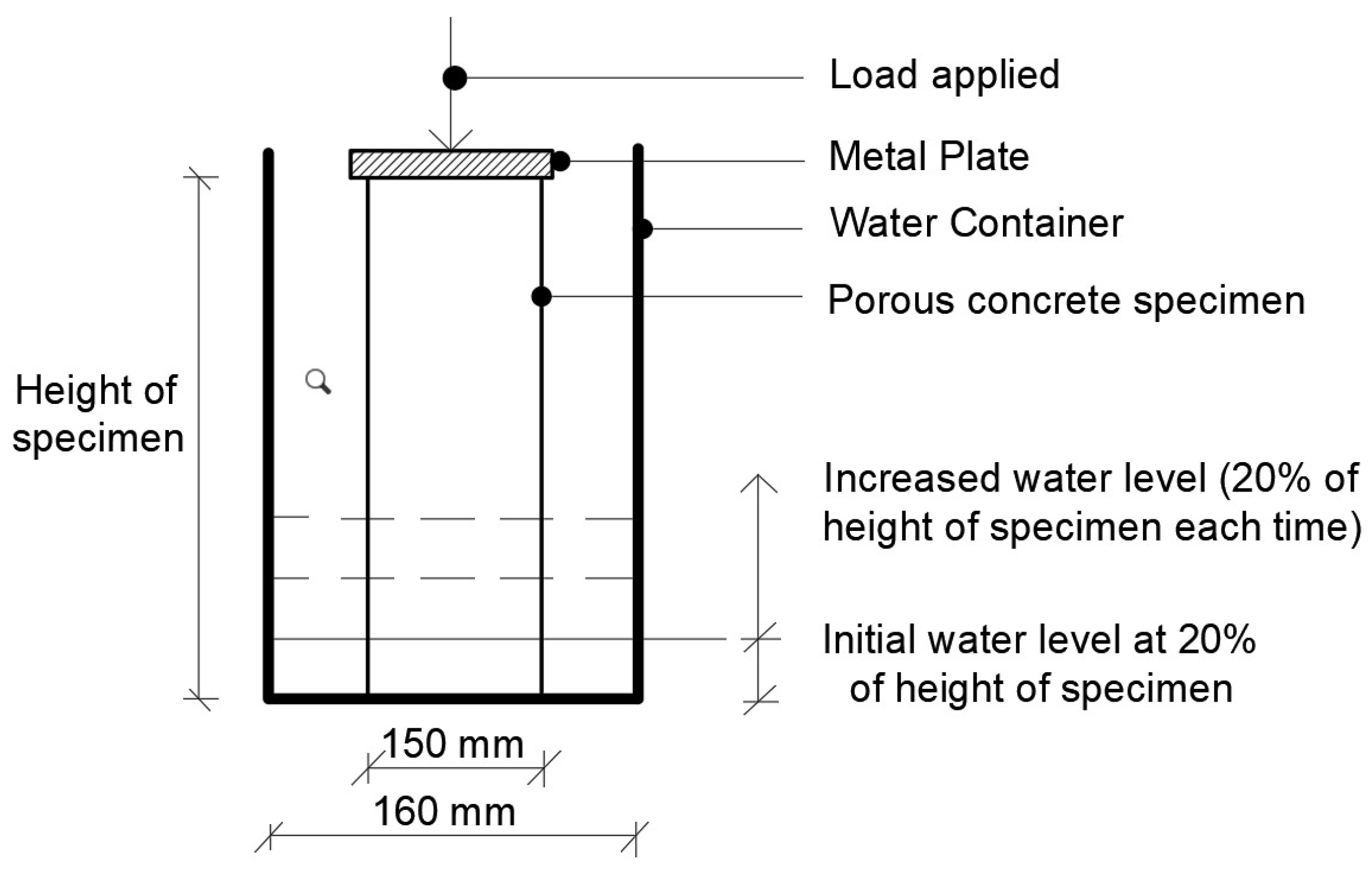

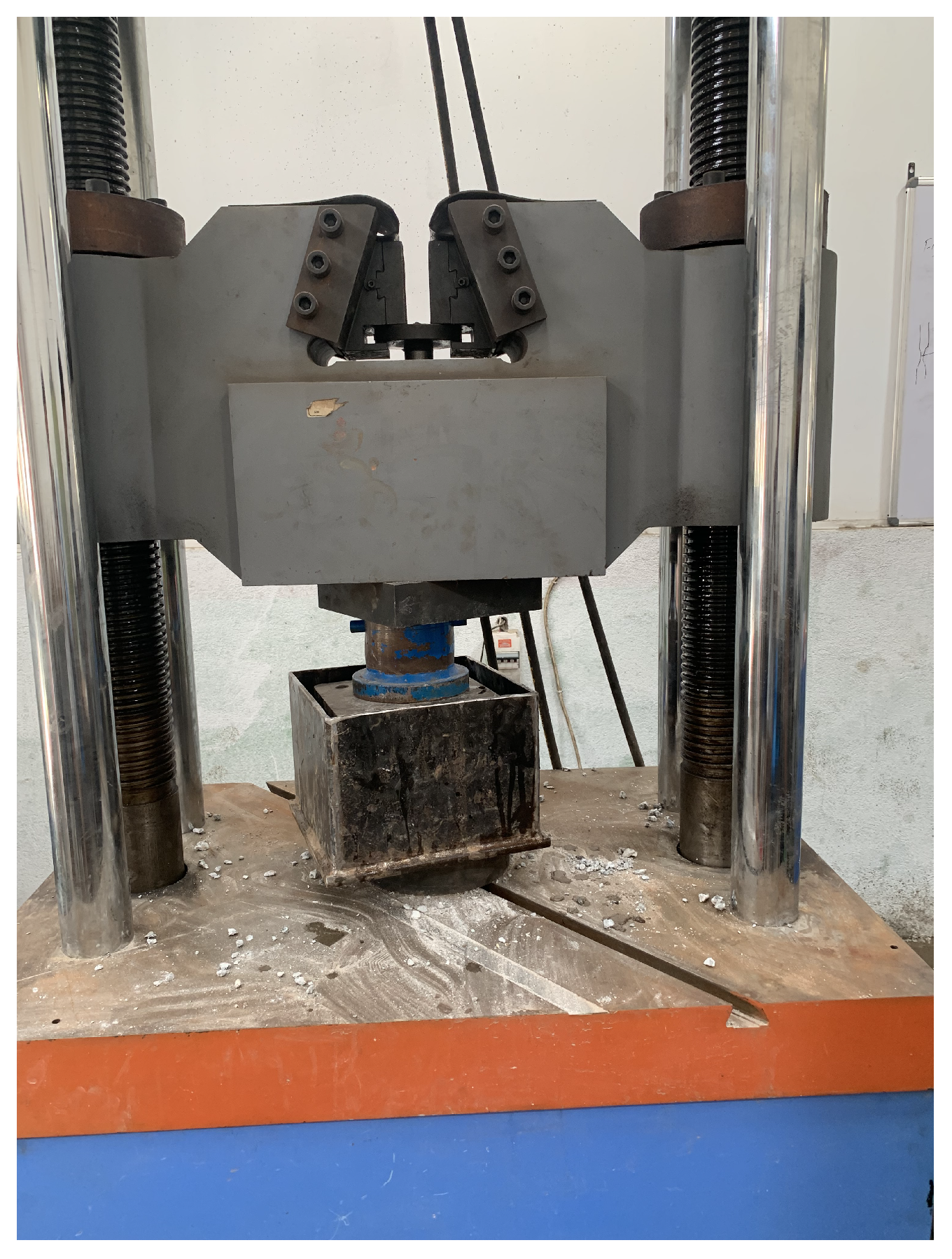
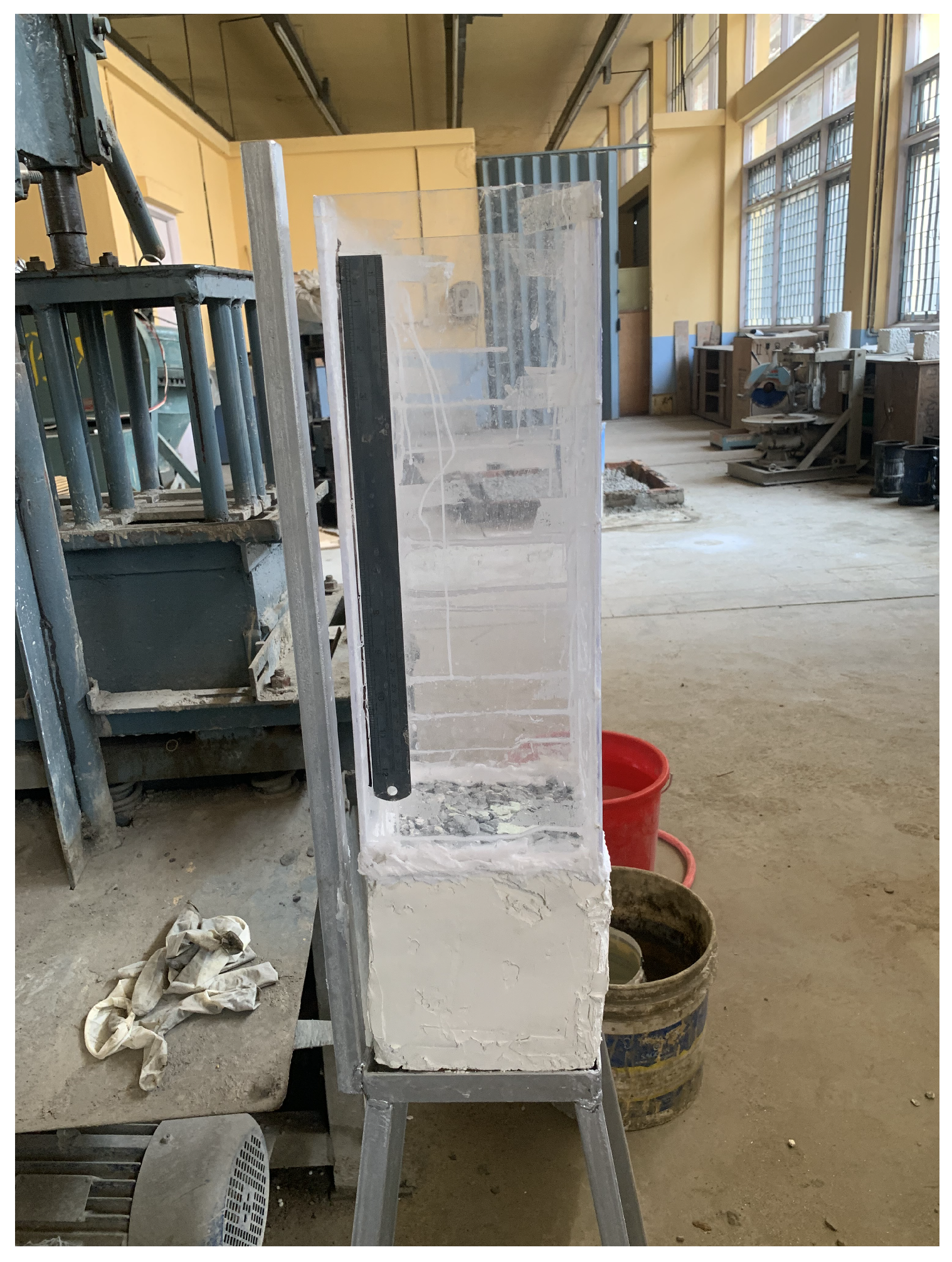
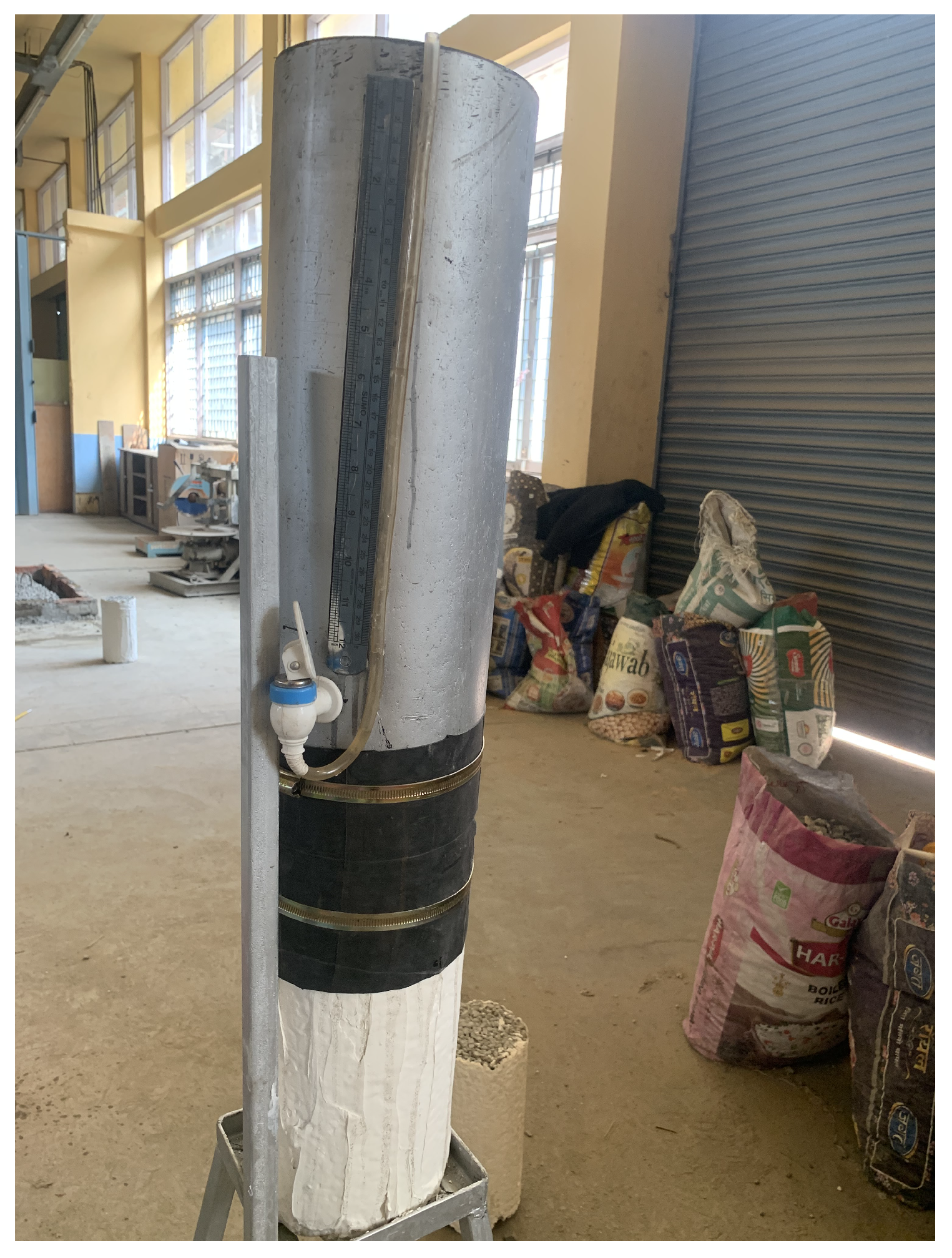

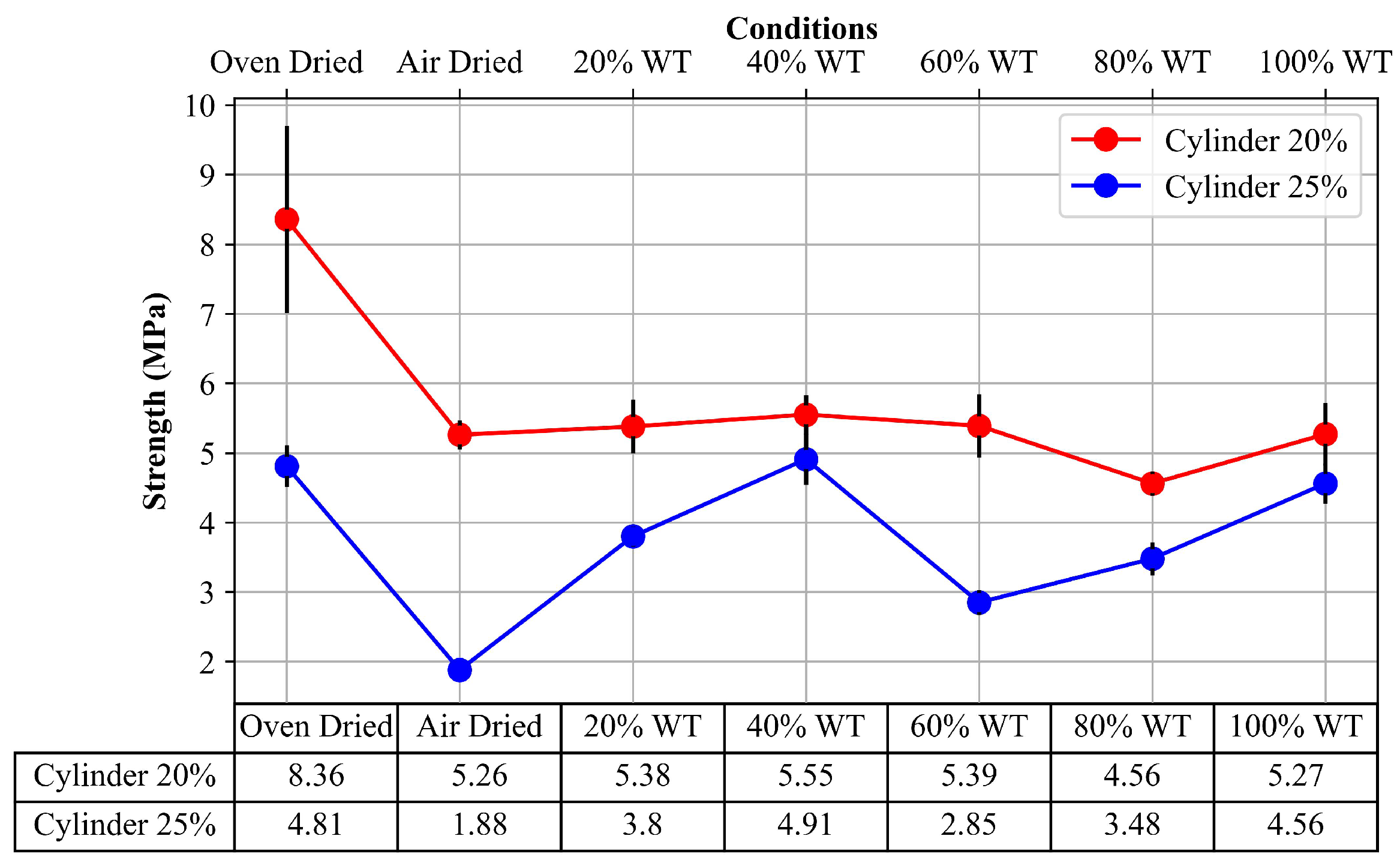


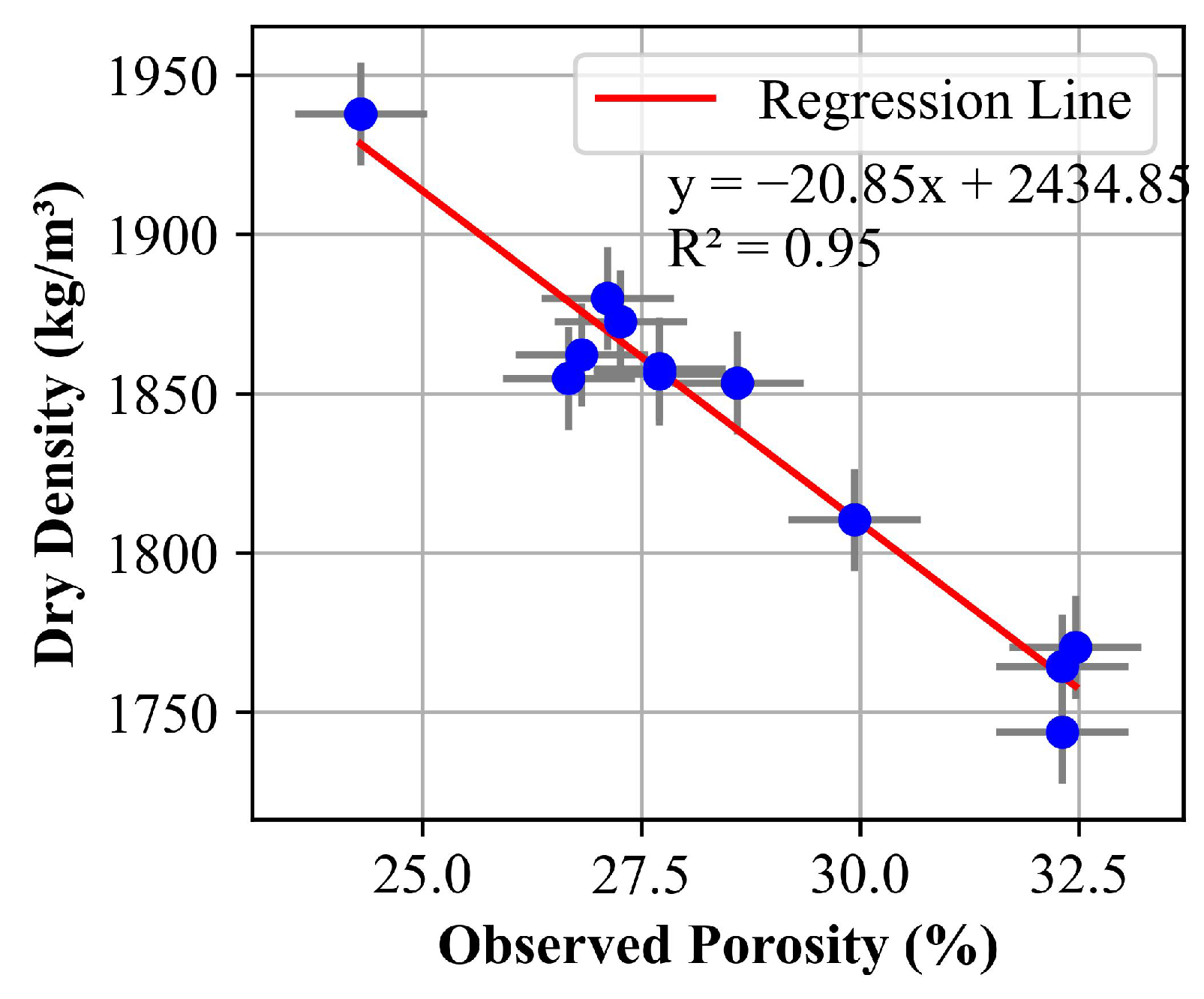

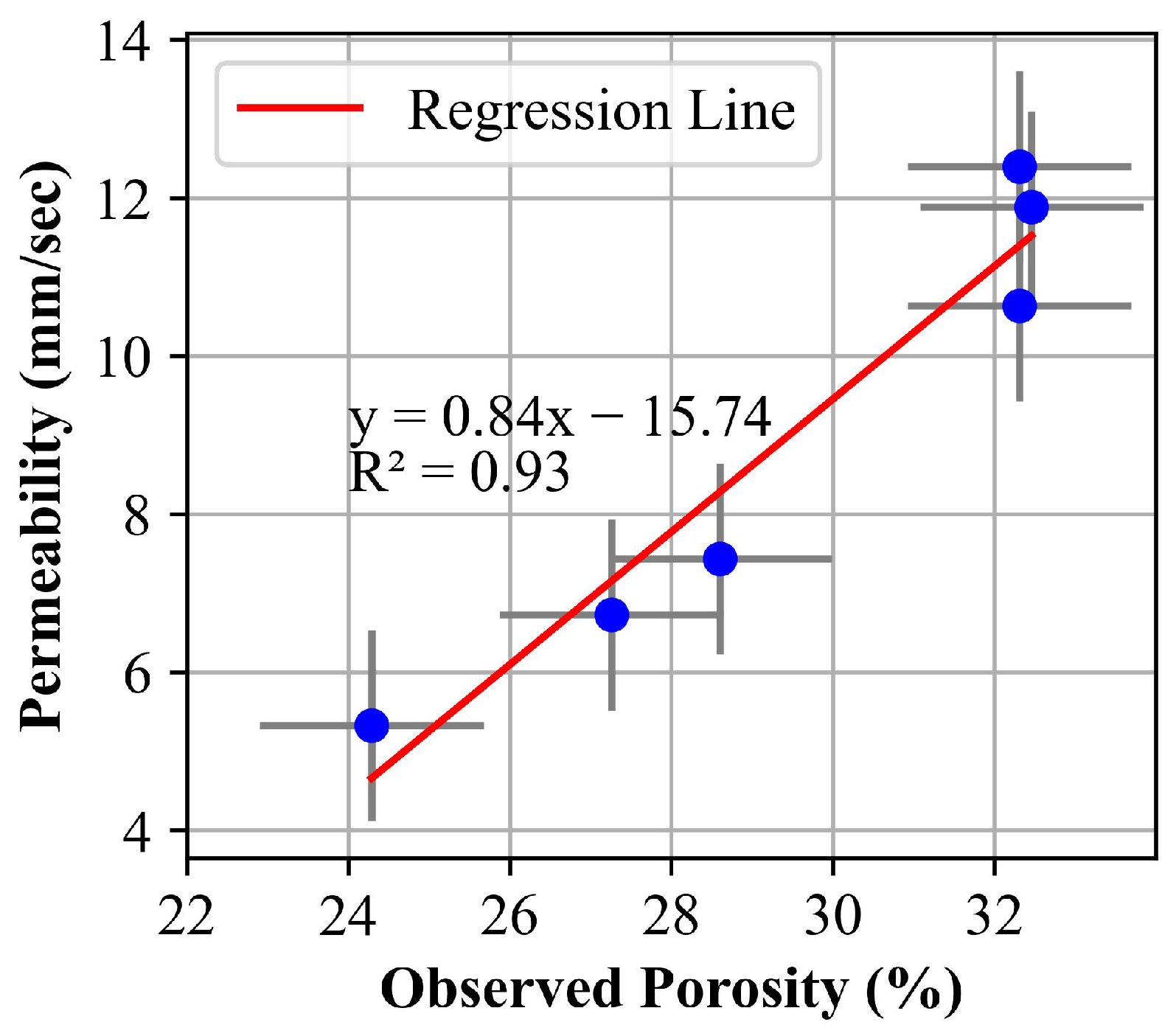

| Aggregate Size | 10 mm–4.75 mm |
| Sp. Gr | 2.64 |
| Bulk Density | 1542.57 kg/m3 |
| Water Absorption | 0.868% |
| Percentage of Deleterious Materials | 4.702% |
| Aggregate Impact Value (AIV) | 35.40% |
| Aggregate Crushing Value (ACV) | 37.39% |
| Void Percentage | 41.50% |
| Description | Design Data-20% Porosity | Design Data-25% Porosity | Remarks |
|---|---|---|---|
| Percentage of Aggregates Voids () | 41.50 | 41.50 | (ASTM C29/C29M) [34] |
| Adopted % of Void () | 20.00 | 25.00 | |
| Cement Paste () | 21.50 | 16.50 | |
| Specific Gravity of Cement | 0.32 | 0.32 | |
| Adopted w/c considering workability | 0.40 | 0.40 | |
| Cement Content () kg/m3 | 300.70 | 230.77 | (ACI Committee 522, 2010) [14] |
| Water Content (kg/m3) | 120.28 | 92.30 | |
| Coarse Aggregate (kg/m3) | 1542.57 | 1542.57 |
| Type of Test | No. of Cube Specimens (150 mm × 150 mm × 150 mm) | Number of Cylindrical Specimens (150 mm × 300 mm) |
|---|---|---|
| Compressive Strength Test | 21 | 21 |
| Normal Condition | ||
| Oven Dried Condition | ||
| Water Level at 20% of height | ||
| Water Level at 40% of height | ||
| Water Level at 60% of height | ||
| Water Level at 80% of height | ||
| Water Level at 100% of height | ||
| Porosity and Permeability | 3 | 3 |
| Normal Condition |
| Sample | Mix Proportion (Cement: Aggregate) | w/c Ratio | Void Percentages |
|---|---|---|---|
| 1:5.13 | 0.4 | 20% | |
| 1:6.69 | 0.4 | 25% | |
| Target Porosity (%) | Observed Porosity Cylinder (%) | Observed Porosity Cube (%) |
|---|---|---|
| 28.93 | 24.29 | |
| 20 | 29.97 | 27.26 |
| 33.85 | 28.6 | |
| 33.75 | 32.31 | |
| 25 | 34.698 | 32.31 |
| 35.45 | 32.46 |
Disclaimer/Publisher’s Note: The statements, opinions and data contained in all publications are solely those of the individual author(s) and contributor(s) and not of MDPI and/or the editor(s). MDPI and/or the editor(s) disclaim responsibility for any injury to people or property resulting from any ideas, methods, instructions or products referred to in the content. |
© 2024 by the authors. Licensee MDPI, Basel, Switzerland. This article is an open access article distributed under the terms and conditions of the Creative Commons Attribution (CC BY) license (https://creativecommons.org/licenses/by/4.0/).
Share and Cite
Lamichhane, R.; Motra, G.B.; Khadka, T.B.; Zhang, Y.X.; Pathak, P.; Pandit, S. Impact of Water Level Variation on Mechanical Properties of Porous Concrete. Sustainability 2024, 16, 3546. https://doi.org/10.3390/su16093546
Lamichhane R, Motra GB, Khadka TB, Zhang YX, Pathak P, Pandit S. Impact of Water Level Variation on Mechanical Properties of Porous Concrete. Sustainability. 2024; 16(9):3546. https://doi.org/10.3390/su16093546
Chicago/Turabian StyleLamichhane, Rabin, Gokarna Bahadur Motra, Thaman Bahadur Khadka, Y. X. Zhang, Prabin Pathak, and Shikhar Pandit. 2024. "Impact of Water Level Variation on Mechanical Properties of Porous Concrete" Sustainability 16, no. 9: 3546. https://doi.org/10.3390/su16093546







